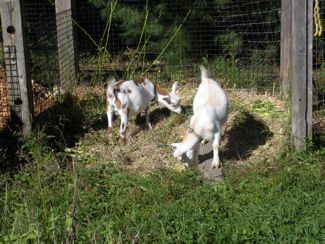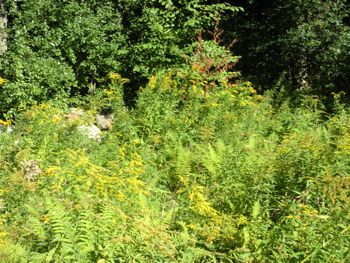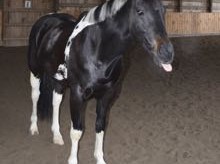The goats’ stall door leads into a small paddock. It’s a very nice place for goats – it shares a fence with the HenCam coop, so the animals can visit (which they do!) It has two large rocks for basking in the sun and play. It has grass. It even has the compost piles.
The compost on the left is fenced off. It’s where the chicken manure and kitchen scraps go. The other side contains the hay and shavings from the kids’ stall. Goats have a reputation for eating everything, but in truth they are very picky eaters. I’d estimate that they reject 40% of the hay from their manger. And if any touches the ground they won’t touch it. Fussier than any horse I’ve ever known! The funny thing is, when I put that trodden on hay on the compost pile, Pip and Caper eat it up.

I think it appeals to their adventurous, foraging natures.
They’re in for a real treat soon – we’ve been working on extending their paddock into the back meadow. I’ll be using fencing especially made for goats and poultry – it’s electrified to keep out the predators, and the netting is small enough that the goats won’t try to squeeze out. We’ll be able to move it around the back pasture and into the woods. The boys should love that.
This patch of golden rod, ferns and brambles will be enclosed soon.

I think we’ll have some happy goats, don’t you?

Actually if the goats aren’t wasting 40% of their given feed, then they aren’t getting enough to eat, and are essentially starving, even if their little bellies look huge. At least that’s true of larger dairy goat breeds. I don’t have much experience with the little guys, but I would assume its similar since these are also a dairy breed. ;)
And yes, you’re going to have some very happy goats! Just a precaution, you might want to walk around in there and make sure there aren’t any poisonous plants that they could get into. Its rare for goats, because of the way they eat, but just a suggestion. :)
Thanks, Kristine. I pulled the milkweed, but think that everything else is edible. Anything else I should worry about here in New England?
Hi, Terry, Happy Labor Day Weekend,
http://netvet.wustl.edu/species/goats/goatpois.txt
Check out # 13 – Hemlock is a fern like looking plant.
and Check #23 – Bracken Fern can cause a lot of problems.
http://allthingsgoat.com/
This is a neat site that I recently found.
I remember having our dairy goat herd was a lot of fun, loved the goats, but at times they could have scary things happen, like I would feed them something that made them sick because I didn’t know any better. Raising goats was a continuous learning process. I always had to be so careful. I remember how picky they were, but loving, each with their own personality. They were like big dogs.
The worst problems we had were when we took the goats to the fair, petting areas, or summer camps. Places where they could pick up problems like pink eye from people or other animals. One of the best pieces of advice I could give you would be to have anyone who touches your goats to wash their hands before and after.
Your goats are darling! watching them makes me think seriously of getting some does, but then I remember our bear problem and I really don’t want to go through the worry.
Thank you for the Hen and Goat Cams!
Callie
Callie- the wusti.ed link is the best I’ve seen for plants toxic to goats. Thanks so much for sending it. I’m going to have to go out and make sure that the ferns aren’t bracken ferns. I don’t think so, but I’ll go double-check!
Looks like someone else beat me to it! ;) Good sites all around. Hope the boys are enjoying their new area. Of course they’re goats, so I can’t imagine them not enjoying it.